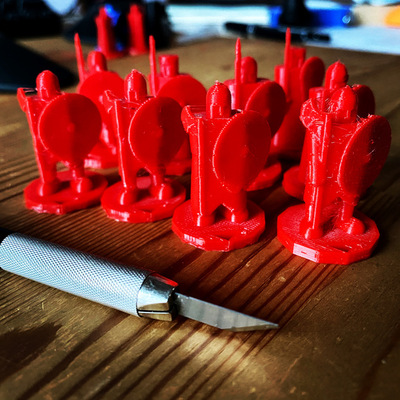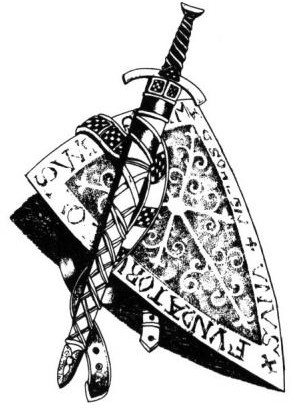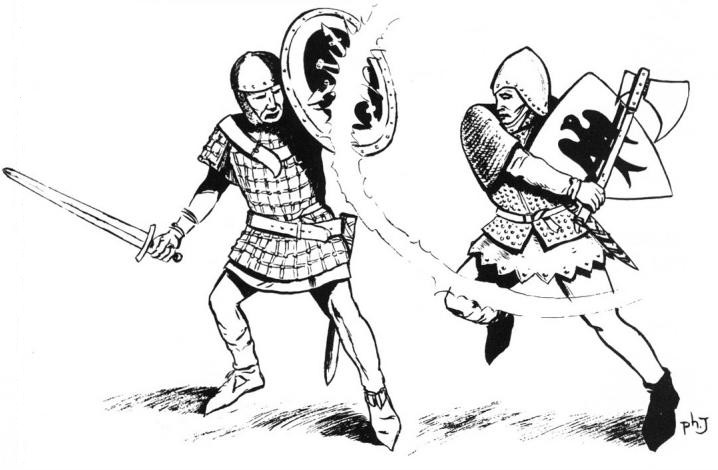
|
Premières Légendes |
| 2021-05-20 |
Premières Légendes

First Legends, its character creation, skill and combat system.
First Legends is a 1985 french role-playing system, that originates in the 1983 Legends system. It is instantiated three times in Celtic Legends, Legends of the Round Table, and Legends of the Valley of the Kings.
I read recently the rules for Legends and did not understand much. I was reading it from the point of view of a First Legends users and almost couldn't find any known landmarks, more than 30 years of distance in time did not help either. Reading the reviews about First Legends, one is told that Legends character creation was a 3 hours long affair and that the system had a reputation of lacking fluidity. First Legends came in as a welcomed rework of Legends.
Gifts and Characteristics
Primo, a character in First Legends has eight gifts, Combat, Magic, Art, Communication, Perception, Mechanics, Nature, and Faith. The player rolls 1d4 for each of them, hoping for fours. Then, the player rolls 2d4 and distributes those extra points on the gifts, respecting the maximum of 8 point for a single gift.
Secundo, a character has two core characteristics: Physical and Mental (French has Physique and Psychique, I translate to Mental for this post). The base score in each of them is 1. The player then rolls 4d4 and distributes the resulting points between Physical and Mental, the maximum score for one of them is 12. A score of 5 to 6 is average, 10, 11 and 12 are exceptional.
Physical has three sub-characteristics, Strength, Speed, and Coordination. Mental has three sub-characteristics, Will, Decision, and Intelligence. The base rule says that a sub-characteristic is equal to its parent characteristic, but there is an optional rule (that we liked very much) that says that points can be shuffled around sub-characteristics within characteristic plus or minus 2 (min 1, max 14). One may thus do:
Physical 10 Mental 11 Appearance 8 Strain points = 2 * 10 + 11 = 31
Strength 12 Will 13 Aura 9
Speed 9 Decision 9 Beauty 9
Coordination 9 Intelligence 11 Honesty 6
I included the third characteristic Appearance and its sub-characteristics Aura, Beauty, and Honesty. The score for Appearance is 3d4-2. Point shuffling by optional rule is possible as well.
Strain points are computed Physical * 2 + Mental. They correspond to the classical Hit Points. There are no levels in this game system and, as you age, you Physical and Mental score might decrease, cascading downstream to skills, strain points, etc.
Skills
Here is the skill tree of the First Legends system. In uppercase our the gifts, in capital case (first letter upper) are the characteristics. The skill names are all lowercase:
COMBAT Physical Mental Appearance
MAGIC Strength Will Aura
ART Speed Decision Beauty
COMMUNICATION Coordination Intelligence Honesty
PERCEPTION
MECHANICS Strain points = 2 * Physical + Mental
NATURE
FAITH
COMBAT ART PERCEPTION NATURE
Physical Mental Coordination Physical
polearm 6m music 2y acrobatics 1y climbing 6m
dagger 6m poetry 1y agility 6m swimming 3m
sword 6m theater 1y handle 1y Coordination
dodge 6m Appearance Mental riding 3m
flail 6m song 2y evaluate ___ 1y Mental
spear 6m dance 1y evaluate ___ 1y dissimulation 6m
bare hands 6m evaluate ___ 1y plant medicine 3y
tournament 1y COMMUNICATION imitate 1y surgery★ 3y
Strength Mental Decision sailing 1y
club 3m humor 1y sense 6m Decision
big shield 6m convince 6m Intelligence horse teaming 6m
axe 6m legends 2y memorize 1y first aid 3m
pommel lance 6m traditions 6m orientation 1y Intelligence
mace 3m Intelligence psychology 3y astronomy★ 4y
big mace 6m greek alphabet★ 6m hunting 6m
Coordination latin alphabet★ 6m MECHANICS animal knowledge 2y
crossbow 3m mathematics★ 2y Coordination beast knowledge 3y
bow 6m Appearance traps 1y plant knowledge 2y
staff 3m seduction 1y poisons★ 1y
sling 3m int gathering 6m MAGIC geology 3y
javelin 3m Aura Intelligence surprise 6m
small shield 6m eloquence 1y hebrew alphabet★ 2y
Mental Honesty FAITH
art of war 4y trading 1y Intelligence
theology★ 3y
See how all skills fall under a gift and a characteristic? For example, in the third column acrobatics falls under Perception and Coordination. Now, gifts (uppercase) range from 1 to 8 and characteristics from 0 to 12 (even 14). 8 + 12 = 20, it's a d20 roll under system.
A character doesn't get all the skills at full Gift + Characteristic score like this. Without formal training the skill score is equal to its gift score (except for skills with a star, like the alphabets or the poisons which start at 0).
Each skill to get its full Gift + Characteristic score has to be learned. This can be done by consuming one learning point and the time specified for the skill (2 years for mathematics, 6 months for axes, etc).
A character receives 12 learning points plus their social status points (see my previous post, nobles whatever their rank receive 7 status points).
First Legends games have classes, each of those classes has 10 mandatory skills. For example, a juggler has to learn dancing, theater, humor, trading, seduction, acrobatics, agility, imitate, handle, and animal knowledge. Their starting age becomes 4d4 + 9 years. The juggler still has (12 + status) - 10 learning points to use. 1 learning point can be used to learn a new skill or to add 1 point to the score of an already learned skill. The player should not forget to add the time spent to his character starting age for those extra skills or extra skill points.
It is totally okay to build a character outside of a class frame, the player just uses the 12 + status learning points and sums up the years required to learn each skill.
Skills
Each skill gets a description in the rules. There are skill usage suggestions. For example, here is eloquence:
# Eloquence (Aura) 1 year Contrarily to the Convince skill, eloquence favors form over content. It's the art of convincing an audience with beautiful sentences. In case of debate, the success margin of the speakers are compared. ## Advise (+3) The higher the success margin, the easier the pieces of advice and suggestions will be accepted. ## Enthuse (0) Rally the audience to your advice. ## Fanaticize (-3) If successful, the character fanaticize their audience before a fight or any other task requiring iron will and a fair amount of energy. In case of success, the audience benefits from a +1 modifier on any tentative for the task, for a duration of success margin x 1 minute. Strain: 1 point
First Legends actively uses success margins and failure margin. For instance if a character tries to convince an audience, with Eloquence 15 and rolls a 9, the margin of success is 6. If one looks at the Charte Angoumoise, a 6 corresponds (second column) to "Very Good".
A second thing to notice is that using some of the skills may lead to straining.
Combat Skills
Here are the description of three combat skills, sword, big shield and dodging:
# Sword (physical) 6 months Do not forget that the sword is reserved to Knights and Nobles. ## Short sword Attack (+2), Parry (-3), min strength 1 hand 3, min coordination 2 ## Broadsword Attack (+3), Parry (-2), min strength 1h 7, min coordination 2 ## Longsword Attack (+3), Parry (-2), min strength 1h 6, min coordination 2 ## Bastard sword Attack (+3), Parry (-3), min strength 1h 10 2h 8, min coordination 2 ## Espadon Attack (+4), Parry (-4), min strength 2h, min coordination 2
# Big Shield (strength) 6 months ## Big round shield Parry (0), min strength 1h 6, min coordination 1 The regular footman shield. ## Big knight shield Parry (0), min strength 1h 5, min coordination 1 Parry (+3) against missiles. The shield used by knights when on foot.
# Dodging (physical) 6 months This skill lets a character avoid an attack completely. ## Dodging (0) The character dives out of reach (3 meters approximately), they need a full turn to dodge and stand up again (no other action possible). ## Feint (-5) The character attempts at avoiding a single attack by a slight move. Another action (attack, parry, or a second feint) may still be attempted in this turn).
Those three descriptions may help piece together the combat system of First Legends. In a turn (3 seconds) a character may perform two actions (attack, parry, dodge or other). Dodging when successful saves the character from any damage.
An attack when successful inflicts its success margin in damage points. The defender may attempt a parry, whose success margin is deducted from the damage points. If the defender is wearing an armor, 2 (leather), 3 (mail), damage points are absorbed. The remaining damage points are subtracted from the strain points.
For example, if Alfred with Sword 15, attacks with his longsword (+3) and rolls 10, is margin is 8. Brand parries with his longsword 14 (-2), he rolls a 9, the damage are reduced by 3. Since Brand is wearing a leather armor, he takes 8 - 3 - 2 = 3 damage points.

Actions are meant to be resolved simultaneously. The rapidity sub-characteristic of the characters may be used to order their declaration of intent (or to introduce an initiative system).
There is an optional rule for critical success and critical failure. For damage for example, rolling a 1 might lead to automatic success, leading to 20 + the margin of success of the second roll (or 0 if that 2nd roll fails) in damage points (before parry and absorption).
Should a character be reduced to 0 strain points, they fall into a coma. Should a character be reduced to minus his max strain points, they immediately die.
Conclusion
I haven't described the magic system and the skill improvement system, but they are not that complicated and are in line with the general skill system.
Creating a character was quite fast, and, when sufficiently skilled in subtraction, the First Legends system is fluid enough. The strain points weren't that numerous so fights weren't that long.
The tournament skill of the Round Table instance was fun and we played some exciting tournament fights with the Knight characters. We also used the localized damage rules a lot and hits to the head were celebrated noisily.
We had a lot of fun as teenagers playing First Legends. We were then lured into Dungeons and Dragons. I have to admit I now feel nostalgic for those clear rules and those success margins. Maybe I could try them again for a one shot.
This post is part of a serie about Premières Légendes (especially its La Table Ronde instance):
- 2021-05-18 La Table Ronde - background tables
- 2021-05-20 First Legends - resolution system and skill system - (the post above)
- 2021-05-24 First Legends Combat - combat resolution system
